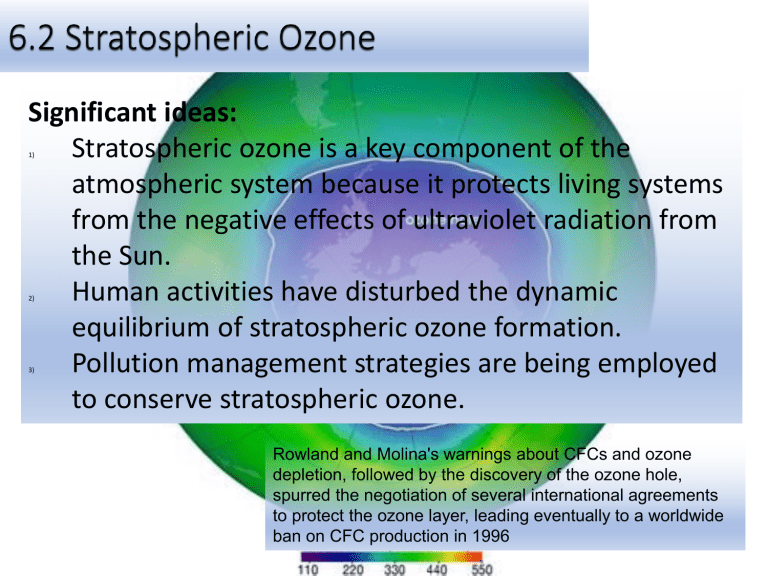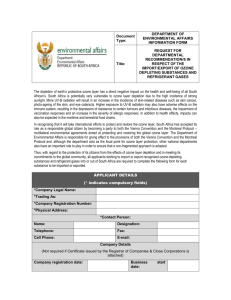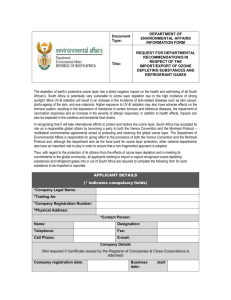
Significant ideas: Stratospheric ozone is a key component of the atmospheric system because it protects living systems from the negative effects of ultraviolet radiation from the Sun. Human activities have disturbed the dynamic equilibrium of stratospheric ozone formation. Pollution management strategies are being employed to conserve stratospheric ozone. 1) 2) 3) Rowland and Molina's warnings about CFCs and ozone depletion, followed by the discovery of the ozone hole, spurred the negotiation of several international agreements to protect the ozone layer, leading eventually to a worldwide ban on CFC production in 1996 Big Questions: • • • To what extent have the solutions emerging form this topic been directed at preventing environmental impacts, limiting the extent of the environmental impacts or restoring systems in which environmental impacts have already occurred? How are the issues addressed in this topic of relevance to sustainability or sustainable development? In what ways might the solutions explored in this topic after your predictions for the state of human societies and the biosphere some decades from now? Big Questions: • • • Why has the Montreal Protocol been so successful? Will it continue to be successful? Outline the links between stratospheric ozone and sustainability/sustainable development. What are the greatest threats to stratospheric ozone likely to be, and from where, in the decades to come? Understandings Statement Guidance 6.2U1 Some ultraviolet radiation from the Sun is absorbed by stratospheric ozone causing the ozone molecule to break apart. Under normal conditions the ozone molecule will reform. This ozone destruction and reformation is an example of a dynamic equilibrium. The use of chemical symbols, formulae or equations for the destruction of ozone is not required. 6.2.U2 Ozone depleting substances (including halogenated organic gases such as chlorofluorocarbons—CFCs) are used in aerosols, gas-blown plastics, pesticides, flame retardants and refrigerants. Halogen atoms (such as chlorine) from these pollutants increase destruction of ozone in a repetitive cycle, allowing more ultraviolet radiation to reach the Earth. 6.2.U3 Ultraviolet radiation reaching the surface of the Earth damages human living tissues, increasing the incidence of cataracts, mutation during cell division, skin cancer and other subsequent effects on health. Understandings Statement 6.2U4 The effects of increased ultraviolet radiation on biological productivity include damage to photosynthetic organisms, especially phytoplankton, which form the basis of aquatic food webs.. 6.2.U5 Pollution management may be achieved by reducing the manufacture and release of ozonedepleting substances. Methods for this reduction include: recycling refrigerants, developing alternatives to gas-blown plastics, halogenated pesticides, propellants and aerosols, developing non-propellant alternatives. 6.2.U6 UNEP has had a key role in providing information, and creating and evaluating international agreements, for the protection of stratospheric ozone. 6.2.U7 An illegal market for ozone-depleting substances persists and requires consistent monitoring. Guidance Understandings Statement 6.2U8 The Montreal Protocol on Substances that Deplete the Ozone Layer (1987) and subsequent updates is an international agreement for the reduction of use of ozone-depleting substances signed under the direction of UNEP. National governments complying with the agreement made national laws and regulations to decrease the consumption and production of halogenated organic gases such as chlorofluorocarbons (CFCs). 6.2.U9 Pollution management may be achieved by reducing the manufacture and release of ozonedepleting substances. Methods for this reduction include: recycling refrigerants, developing alternatives to gas-blown plastics, halogenated pesticides, propellants and aerosols, developing non-propellant alternatives. Guidance Applications and Skills Statement 6.2.A1 Evaluate the role of national and international organizations in reducing the emissions of ozonedepleting substances. Guidance Stratospheric ozone is a key component of the atmospheric system because it protects living systems from the negative effects of ultraviolet radiation from the Sun • What issues have you heard regarding the ozone layer? https://geekswipe.net/research/nature/ozone-layer-will-take-50-years-to-recover-2070/ Stratospheric ozone is a key component of the atmospheric system because it protects living systems from the negative effects of ultraviolet radiation from the Sun • During the Cambrian Explosion, many complex multicellular organisms evolved in the oceans, • Marine organisms became mobile and were able to live in shallower areas of the ocean with greater sunlight exposure. • Around 420 million years ago, ozone levels were high enough to allow for organisms to survive on land, without any shielding from water https://earthhow.com/proterozoic-eon/ 6.2.U1 Some ultraviolet radiation from the Sun is absorbed by stratospheric ozone causing the ozone molecule to break apart. Under normal conditions the ozone molecule will reform. This ozone destruction and reformation is an example of a dynamic equilibrium. Allows UVa and UVb through, but blocks UVc waves • UVa - causes wrinkles • UVb - causes skin cancer • UVc - worst one because of damage to organisms/tissues https://scied.ucar.edu/ozone-layer 6.2.U1 Some ultraviolet radiation from the Sun is absorbed by stratospheric ozone causing the ozone molecule to break apart. Under normal conditions the ozone molecule will reform. This ozone destruction and reformation is an example of a dynamic equilibrium. • Some ultraviolet radiation from the Sun is absorbed by stratospheric ozone causing the ozone molecules to break apart O2 + O + UV → O3 the energy provided by incoming UV light changes O2 → O3 http://www.theozonehole.com/ozonecreation.htm 6.2.U1 Some ultraviolet radiation from the Sun is absorbed by stratospheric ozone causing the ozone molecule to break apart. Under normal conditions the ozone molecule will reform. This ozone destruction and reformation is an example of a dynamic equilibrium. • Under normal conditions the ozone molecule will reform. • This ozone destruction and reformation is an example of a dynamic equilibrium https://en.wikipedia.org/wiki/Ozone_layer Click image for more information on ozone production Evaluate the diurnal fluctiation of atmospheric ozone 6.2.U2 Ozone depleting substances (in clouding halogenated organic gases such as chlorofluorocarbons-CFCs) are used in aerosols, gas-blown plastics, pesticides, flame retardants and refrigerants. Halogen atoms (such as chlorine) from these pollutants increase destruction of ozone in a repetitive cycle, allowing more ultraviolet radiation to reach the Earth • How ozone is depleted by CFC’s: Click on the image to watch a video on ozone depletion 6.2.U2 Ozone depleting substances (in clouding halogenated organic gases such as chlorofluorocarbons-CFCs) are used in aerosols, gas-blown plastics, pesticides, flame retardants and refrigerants. Halogen atoms (such as chlorine) from these pollutants increase destruction of ozone in a repetitive cycle, allowing more ultraviolet radiation to reach the Earth Click on the image to watch a video on ozone depletion Human activities have disturbed the dynamic equilibrium of stratospheric ozone formation There are two important things to remember here 1. The 1-2-3 sequence outlined at right 2. The class of ozone-depleting chemicals at the center bottom 6.1U3 Ultraviolet radiation reaching the surface of the Earth damages human living tissues increasing the incidence of cataracts, mutations during cell division, skin cancer and other subsequent effects on health https://www.gayaopticians.com/uv-an-invisible-danger/ 6.1U3 Ultraviolet radiation reaching the surface of the Earth damages human living tissues increasing the incidence of cataracts, mutations during cell division, skin cancer and other subsequent effects on health • DNA readily absorbs UV-B radiation, which commonly changes the shape of the molecule • Changes often mean that protein-building enzymes cannot “read” the DNA code at that point on the molecule. • As a result, distorted proteins can be made, or cells can die. https://earthobservatory.nasa.gov/features/UVB 6.1U3 Ultraviolet radiation reaching the surface of the Earth damages human living tissues increasing the incidence of cataracts, mutations during cell division, skin cancer and other subsequent effects on health https://freeness.us/gel-manicures-linked-to-skin-cancer/ 6.1U3 Ultraviolet radiation reaching the surface of the Earth damages human living tissues increasing the incidence of cataracts, mutations during cell division, skin cancer and other subsequent effects on health Beneficial Effects of UV • In animals stimulates the production of Vit D. • Treat psoriasis and vitiligo (skin diseases) • Steriliser, water purifier • Forensics, lighting, lasers 6.1U3 Ultraviolet radiation reaching the surface of the Earth damages human living tissues increasing the incidence of cataracts, mutations during cell division, skin cancer and other subsequent effects on health Take care not to confuse effects of ozone decline in the stratosphere (i.e. increase in UV radiation reaching the earth) with impacts of ozone in the troposphere. 6.2.U4 The effects of increased ultraviolet radiation on biological productivity include damage to photosynthetic organisms, especially phytoplankton which form the basis of aquatic food webs • Phytoplankton do not exist in isolation • Other microbes, the protozoa, bacteria and viruses, can be directly damaged or killed by solar UVB. • Due to the interactions between trophic levels of the microbial community, any UVB-induced impact at one level can alter the entire community http://www.antarctica.gov.au/magazine/2001-2005/issue-1-autumn-2001/science/effect-ofozone-depletion-on-antarctic-marine-microbes 6.2.U4 The effects of increased ultraviolet radiation on biological productivity include damage to photosynthetic organisms, especially phytoplankton which form the basis of aquatic food webs • Plants are vulnerable to increased UV-B radiation because many cellular components can absorb UV directly • Increased UV-B radiation has many effects on plant morphology, physiology and development, and its impacts on growth and development • Reduction in biomass accumulation due to UV-B exposure has been verified • Many plants exposed to this radiation exhibit decreased rates of photosynthesis 6.2U6 UNEP has had a key role in providing information and creating and evaluating international agreements, for the protection of stratospheric ozone. International Agreements • The United Nations (UN) was instrumental in establishing binding legislation to encourage countries to reduce damage to the ozone layer. • Vienna Convention in 1985 • Montreal Protocol in 1987. • In 2009, it became the first UN treaty to be ratified by all 197 nations. 6.2.U8 The Montreal Protocol on Substances that Deplete the Ozone Layer (1987) and subsequent updates is an international agreement for the reduction of use of ozone-depleting substances signed under the direction of UNEP. National governments complying with the agreement made national laws and regulations to decrease the consumption and production of halogenated organic gases such as chlorofluorocarbons (CFCs) Progress Implementation of the Montreal Protocol has resulted most of the main ODS to be banned with some exceptions for medical and research use. • CFCs production has stopped and are resulting in atmospheric levels stabilizing or declining. • Production of halons has stopped, but atmospheric levels continue to rise, possibly due to emissions from old fire extinguishers. Adoption and performance of the Montreal Protocol reporting the cumulative number of countries ratifying the Montreal Protocol, area of the ozone hole, and production of CFCs. http://ozone.unep.org/new_site/en/index.php; http://ozonewatch.gsfc.nasa.gov/. 6.2.A1 Evaluate the role of national and international oganizations in reducing the emissions of ozone-depleting substances Why is the Montreal Protocol regarded as one of the most successful international environmental agreements in history? Justify your response with evidence, named examples, and/or specific case studies http://www.theozonehole.com/dualbenefits.htm 6.2.A1 Evaluate the role of national and international oganizations in reducing the emissions of ozone-depleting substances Watch the following video by UNEP which provides a summary of some the key issues of stratospheric ozone depletion. Answer the questions on the study guide 6.2.A1 Evaluate the role of national and international oganizations in reducing the emissions of ozone-depleting substances HFC Kigali Amendment to the Montreal Protocol – 2019 • HFCs harm the atmosphere • environmental issues need to be addressed at an intergovernmental level; • changes in behavior • MEDCs agreed to provide financial assistance LEDCs; • technological development has found alternatives to HFCs; 6.2.A1 Evaluate the role of national and international oganizations in reducing the emissions of ozone-depleting substances • Your response must include named references to both national organizations and international organizations involved in the reduction of ozone-depleting emissions. • Remember that evaluate means weighing the pros and cons and make a determination as to which are more significant Click on the logo to get a history of the Montreal Protocol https://sgerendask.com/en/short-history-of-the-montreal-protocol-and-holes-in-the-ozone-layer/ 6.2.A1 Evaluate the role of national and international oganizations in reducing the emissions of ozone-depleting substances Watch the following video Explain how the Kigali Accord supports the protection of the ozone layer and takes action against climate change 6.2.U7 An illegal market for ozone-depleting substances persists and requires consistent monitoring Challenges Click on the image to watch a video on “Someone in East Asia is Damaging the Ozone Layer” https://www.bloomberg.com/news/articles/1997-07-06/the-black-market-vs-dot-the-ozone 6.2.U7 An illegal market for ozone-depleting substances persists and requires consistent monitoring Challenges • Long life span of ODS • ODS present in discarded equipment • Lack of alternatives • Replacement chemicals also ODS • Lack of policing and enforcement • Illegal markets http://www.sviva.gov.il/English/env_topics/InternationalCooperation/IntlConventions/Pa ges/ViennaConvention.aspx 6.2.U7 An illegal market for ozone-depleting substances persists and requires consistent monitoring Challenges • CFC emissions should have followed the blue trend line, according to numbers reported to the UN • However two different monitoring methods (red and orange trend lines) show that CFC emissions started to rise again in 2012 https://gosint.wordpress.com/2018/05/18/the-rise-of-the-cfc-an-atmospheric-spythriller/ 6.2.U7 An illegal market for ozone-depleting substances persists and requires consistent monitoring Challenges • Data points indicate the source is north of the equator and somewhere in eastern Asia https://gosint.wordpress.com/2018/05/18/the-rise-of-the-cfc-an-atmospheric-spythriller/ 6.2U5 Pollution management may be achieved by reducing the manufacture and release of ozone-depleting substances. Methods for this reduction include: From most effective strategy to the least effective: • Tier 1: Campaign to educate public and pressure, industry to find and use suitable replacement • Tier 2: Policing and enforcement to ensure compliance, recover and recycle CFC’s from refrigerators and AC units • Tier 3: Remove and destruction of ozone-depleting compounds https://www.agasamericas.com/products-services/refrigerants/ 6.2U5 Pollution management may be achieved by reducing the manufacture and release of ozone-depleting substances. Methods for this reduction include: Evaluate – weight the pros and cons, then reach conclusions about which are more significant • Think of it as a cost benefit analysis • How is each intervention level successful? • What hinders the success of each intervention level? • Which level is likely to be the most effective and feasible to implement? • Justify your conclusion with reasons and evidence




